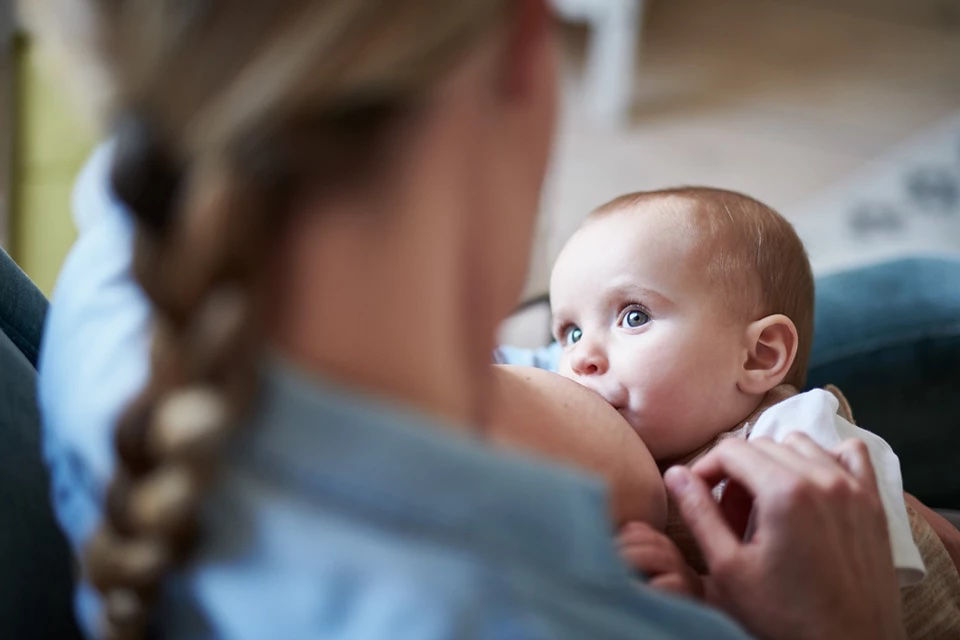33 weeks pregnant

Explore pregnancy stages week by week
At 33 weeks pregnant, there’s a lot going on for both you and your baby - it’s an exciting time. As you get closer to your due date, you might be thinking about your new life as a parent and the choices that are right for you and your family.
Let’s look at what’s going on during your pregnancy at 33 weeks pregnant, including some of those common pregnancy symptoms, recognising Braxton Hicks contractions, and some delicious meal planning and inspiration for your third trimester.

What are the pregnancy symptoms at 33 weeks pregnant?
At 33 weeks pregnant, your growing baby continues to take up more of the available space in your tummy. As a result, you may find that your appetite decreases, leaving you unable to eat large or full meals1. Try to eat little and often instead - you’ll find plenty of healthy and nutrient-packed ideas below.
Heartburn and acid reflux are also one of the common pregnancy symptoms at 33 weeks. They’re thought to be caused by the many hormonal changes going on inside your body as your pregnancy progresses, and your growing baby pressing on your stomach2.
Back pain is quite common throughout pregnancy, including during the third trimester. It’s caused by the ligaments in your body softening and stretching in preparation for giving birth3.
Other symptoms you might be experiencing at 33 weeks include4:
- Difficulty sleeping
- Stretch marks - you can learn more about the physical changes you might experience during your pregnancy here
- Headaches
- Swollen hands and feet
- Bleeding gums
On the upside, you may notice that your hair has started to feel thicker and look shinier one of the more enjoyable symptoms of pregnancy!
Whilst these symptoms are very common and unlikely to be a cause for concern, be sure to seek advice from your doctor or midwife if you’re struggling to manage your symptoms.
Braxton Hicks at 33 weeks pregnant
If you feel a ‘tightening’ across your abdomen from time to time at 33 weeks pregnant, this could be a sign that your body is starting to prepare for labour with Braxton Hicks contractions. These tend to last for around 20 to 30 seconds, at which point the muscles start to relax4.
Braxton Hicks contractions at 33 weeks are very common and shouldn’t cause you any pain. If they start to become painful, you get any unusual cramping, or they start to happen more regularly, then it’s very important that you contact your midwife to seek advice4.
33 weeks pregnant - symptoms not to ignore
Whilst most pregnancy symptoms are completely normal, you should seek medical advice if you notice any of the following5:
- Any changes in your baby’s usual movement patterns
- Swelling in your face, hands and feet, as this can be a sign of pre-eclampsia
- If you suspect that your waters have broken
Your baby at 33 weeks pregnant
At 33 weeks pregnant, your baby measures roughly 43.7 cm from their head to their heel4. Your baby’s brain is now fully developed, as is their nervous system, and in the coming weeks, your baby will be focussed on accumulating fat and growing to full term4.
During this time, whilst your baby’s bones will be getting harder, their skull will remain soft and separated. This is to allow your baby to more easily make their way down the birth canal during labour. Interestingly, your baby’s skull will stay this way until they reach between the ages of 12 and 18 months4.
Your pregnancy diet at 33 weeks pregnant
Reviewed by Bahee van de Bor
During your third trimester, you’ll probably need an additional 200 calories per day to provide you with the energy you need (the equivalent of two slices of wholemeal toast)4.
Whilst you don’t need to follow a special diet during your pregnancy unless you’ve been advised to do so by your doctor or midwife6, eating a healthy and balanced variety of foods is essential for the health of you and your baby. Try to avoid eating too many salty, processed or fatty foods (pregnancy cravings can make this a bit of a challenge!) and be sure to include plenty of fruit and vegetables in your daily diet.
Little and often
Late in your third trimester, your baby is taking up most of the space your stomach used to occupy. Depending on your appetite, you may find that it’s more comfortable to eat smaller portions of food more often.
Try grazing on healthy snacks throughout the day and at either side of your meals. This will ensure that you and your baby both receive a steady supply of nutrients and energy as your third trimester progresses. It may also help you to manage some of those week 33 pregnancy symptoms such as heartburn.
Key nutrients to include at 33 weeks pregnant
Vitamin D
Vitamin D is essential during your pregnancy, as it helps to support the bones, teeth and muscles7. The NHS recommends that all pregnant and breastfeeding women take a 10mg daily supplement of vitamin D during the months of September to March. This is because the primary source of our vitamin D comes from the sunlight exposure (which triggers the skin to produce vitamin D naturally), and sunlight is in short supply during the winter months7.
If you have darker skin tones, live with obesity, or spend the majority of your day indoors, your vitamin D intake recommendation is 20-25 mcg per day8.
For a vitamin D rich healthy meal or snack, why not try sardines on toast, or a bowl of fortified, unsweetened breakfast cereal with milk? But do remember that you still need to take a vitamin D supplement every day when you’re pregnant to get all the vitamin D you and your baby need.
Iron
Not getting enough iron in your diet can leave you feeling very tired and lacking in energy7. Iron also helps both you and your baby to make the haemoglobin in red blood cells9 and supports the development of your baby’s brain10.
Some iron-rich meal ideas include:
- Hummus and wholemeal pitta slices with spinach
- Baked beans on a jacket potato (try opting for a reduced salt variety of baked beans)
- A wrap filled with cooked beef or roast beef
- A handful of dried apricots, figs or prunes
Long chain polyunsaturated fatty acid (LCPs)
DHA, a type of omega-3 fatty acid, is vital for supporting your baby’s growth in the womb, helping your baby’s brain, eyes11, and nervous system to develop12. You can learn more about the benefits of omega-3 during your pregnancy here.
Try these snacks and light meals for a nutritious boost during your day:
Grilled trout with salad
Smoked salmon sandwich
A handful of nuts and seeds
Soya milk fruit smoothie
Remember to limit your intake of oily fish such as salmon, trout or mackerel to 2 portions per week during your pregnancy12.
Next steps for your third trimester
As your due date gets closer, there are one or two practicalities that you might want to start thinking about.
If you’re attending an antenatal class, this is the perfect opportunity for you to ask any questions you might have about your labour and birth, and what life with your little one may look like. Your antenatal appointments with your midwife can also be very helpful, providing plenty of information about everything from pain relief during labour to breastfeeding.
It’s also time to start thinking about packing your hospital bag. Even if you’re planning for a home birth, it’s a good idea to have a hospital bag prepared, just in case you’re advised to transfer into hospital once your little one has arrived.
Why not create a hospital bag checklist, just to make sure that you’ve got all bases covered? Remember to include the things that will help you during your labour (think healthy snacks for labour and comfortable clothing), and the things you and your baby will need once you’ve given birth. Toiletries, nappies and baby clothes for example.
To help you get started, you can download your free copy of our handy hospital bag checklist here.
related articles
Read More

Need some help?
You can get quick answers to common questions in our FAQs.
Alternatively, if you need help with general pregnancy or baby advice, or maybe on using or ordering our products - our expert team are always on hand to talk about feeding your baby.
NHS Portsmouth Hospitals NHS Trust. Pregnancy Diary Third Trimester Weeks 27-41 [online] https://www.porthosp.nhs.uk/departments/maternity/assets/Pregnancy_Diary_Third_Trimester_Weeks_27-41.pdf. [Accessed November 2024]
NHS. You and your baby at 33 weeks pregnant [online] 2021. https://www.nhs.uk/pregnancy/week-by-week/28-to-40-plus/33-weeks/. [Accessed November 2023]
NHS. Back pain in pregnancy [online] 2021. Available at https://www.nhs.uk/pregnancy/related-conditions/common-symptoms/back-pain/. [Accessed November 2023]
NHS Start for Life. Week 33 [online]. Available at https://www.nhs.uk/start-for-life/pregnancy/week-by-week-guide-to-pregnancy/3rd-trimester/week-33/. [Accessed November 2023]
NHS Hull University Teaching Hospitals. The Third Trimester: Entering the home straight of pregnancy [online] 2018. Available at https://www.hey.nhs.uk/news/2018/07/19/the-third-trimester-entering-the-home-straight-of-pregnancy/. [Accessed November 2023]
NHS. Have a healthy diet in pregnancy [online] 2023. Available at https://docs.google.com/document/d/1euHzJlcQMEX-fS030wd3XFGtSi5xlnwxNOMIpXzMx4Q/edit. [Accessed November 2023]
NHS. Vitamins, supplements and nutrition in pregnancy [online] 2023. Available at https://www.nhs.uk/pregnancy/keeping-well/vitamins-supplements-and-nutrition/. [Accessed November 2023]
Alhomaid RM, Mulhern MS, Strain J, Laird E, Healy M, Parker MJ, McCann MT. Maternal obesity and baseline vitamin D insufficiency alter the response to vitamin D supplementation: a double-blind, randomized trial in pregnant women. Am J Clin Nutr. 2021 Sep 1;114(3):1208-1218. doi: 10.1093/ajcn/nqab112. PMID: 33964855; PMCID: PMC8408850.
NHS Inform. Vitamins and minerals in pregnancy [online] 2023. Available at https://www.nhsinform.scot/ready-steady-baby/pregnancy/looking-after-yourself-and-your-baby/vitamins-and-minerals-in-pregnancy/. [Accessed November 2023]
NHS Hull University Teaching Hospitals. Anaemia in Pregnancy [online] 2019. Available at https://www.hey.nhs.uk/patient-leaflet/anaemia-in-pregnancy-2/#:~:text=During%20pregnancy%20the%20body's%20demand,has%20shown%20you%20are%20anaemic. [Accessed November 2023]
Coletta JM, Bell SJ, Roman AS. Omega-3 Fatty acids and pregnancy. Rev Obstet Gynecol. 2010 Fall;3(4):163-71. PMID: 21364848; PMCID: PMC3046737
NHS. Fish and shellfish [online] 2022. Available at https://www.nhs.uk/live-well/eat-well/food-types/fish-and-shellfish-nutrition/#:~:text=Long%2Dchain%20omega%2D3%20can,long%2Dchain%20omega%2D3. [Accessed November 2023]








